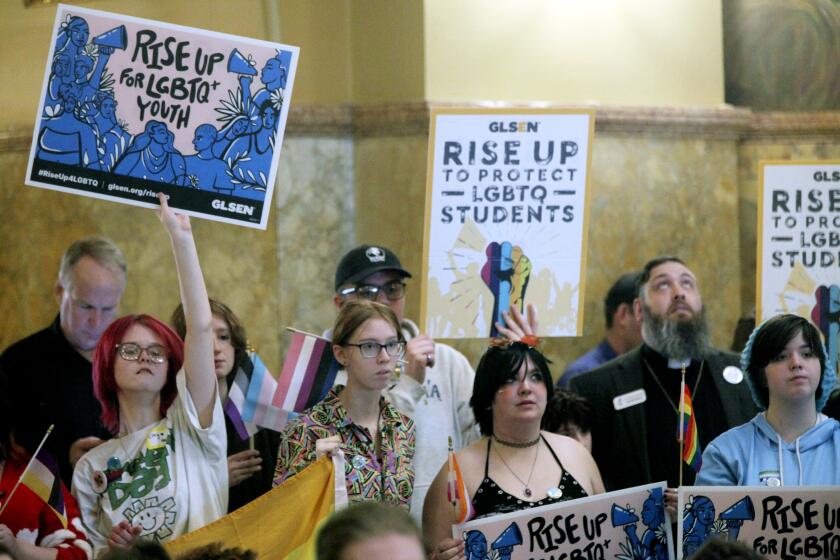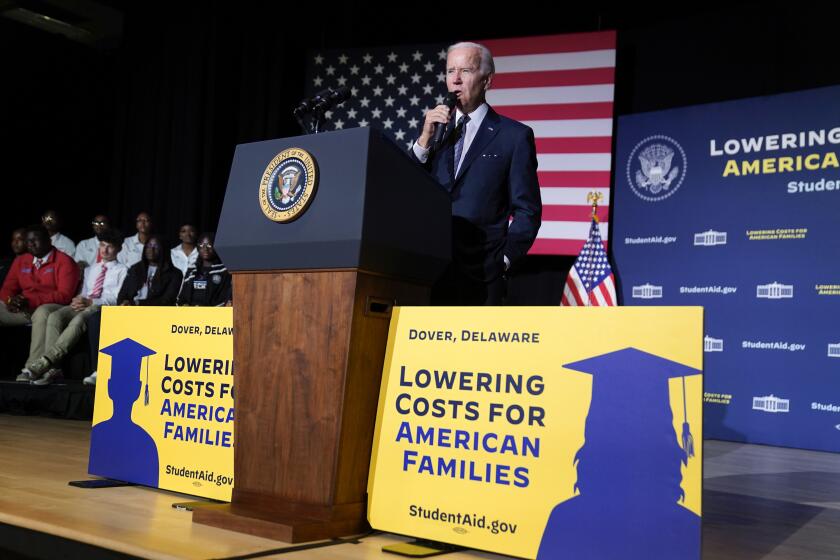UC Must Build 3 New Campuses to Meet Expected Enrollment Boom, Regents Told
The University of California must build three new campuses in the next 12 years to accommodate an expected enrollment boom, UC President David P. Gardner said Thursday.
Locations for the proposed new schools have not been chosen, Gardner told the UC Board of Regents meeting here. Their construction would cost a total of $900 million and would require controversial changes in state spending limits, he said.
The proposal is sure to provoke much debate among the regents and in the Legislature, both of which must approve it. The regents took no action Thursday and will take the matter up again at their November meeting.
The ambitious plan is “rooted in the belief that Californians will wish to provide for UC in the future, as they have in the past, and that UC will continue to grow with the state, as it has since its chartering in 1868,” Gardner told UC Regents.
The university expects its enrollment to jump from 154,000 now to 217,000 by 2005. The existing nine UC campuses can add a total of only 43,000 students because of land shortages, community opposition to growth and a sense that the quality of education declines if a school is too big, UC officials said.
That would leave another 20,000 eligible students without a place in the University of California unless the new campuses are opened in 1998, 1999 and 2000, according to a UC analysis.
In the past, Gardner had speculated about the possible need for new campuses, but his announcement Thursday was the first time that he presented it as formal policy, with dollars and years. The scope of his plan surprised some UC educators, who expected him to recommend only one additional campus.
Gardner hopes for quick support.
“If you want a campus by (1998), you have to begin to plan for it in 1989,” he said.
On Thursday, some regents appeared skeptical and asked whether it would be cheaper to expand existing campuses more than planned and to encourage more students to start their higher education at community colleges and then transfer to a UC campus. Others, like regents Chairman Leo Kolligian, expressed strong approval,
William B. Baker, UC vice president for budget and university relations, said it would be more expensive at the start to build new campuses then to rapidly expand the current nine. But he said that after five years, the costs would be about the same.
UC officials urged changes in the Gann amendment, which limits increases in state spending to rises in inflation and population.
“The assumption, of course, is that the money will be forthcoming. If the money is not forthcoming, there will not be new campuses,” Gardner said.
Peter Mehas, the governor’s education adviser, said the Administration could not comment on Gardner’s plan until the governor has a chance to look at it more closely and put it in context of the growth of the California State University and the community colleges.
Asked if he thought the other two systems would oppose it, Mehas said: “Maybe I’m somewhat naive, but I don’t think there will be a turf war.”
Gardner said he has established no criteria yet for choosing the three locations, other than cities that “would welcome them and accommodate them.” More than 30 cities around the state have been lobbying to become UC host communities.
Interest is particularly strong in the San Joaquin Valley, which has a low UC attendance rate, and from the most northern parts of the state. Kolligian has long been boosting his hometown, Fresno. On Thursday, he said he would not comment on his preference for a new campus site.
Other UC officials speculated that one of the locations would have to be in Southern California because of population and political pressures there. However, siting in Southern California would be more difficult because of the high price of land. In addition, Cal State, the second tier of public higher education, already plans to open new campuses in northern San Diego County and in Ventura.
Immigration Rise
The University of California is in a bind, Gardner and his staff said, because of a rise in immigration to the state and because of children of the Baby Boomers born after World War II. Also, the relative bargain of the UC education, compared to private colleges, is attracting more students.
According to the staff’s analysis, UC Berkeley, currently with 30,576 students, is too large and should drop to 29,450 by 2005. At the same time, UCLA can add only 526 students to its current total of about 34,000, and UC San Francisco, a health sciences school with mainly graduate students, will add only 426 to its 3,600.
Of the six other UC campuses, three--Santa Barbara, Santa Cruz and Davis--face opposition to much growth from area residents and politicians. Under the new plan, UC Santa Cruz would grow to 15,000 students, an increase of 6,051. UC Santa Barbara would enroll 20,000, only 2,176 more than now. UC Davis would have 26,850, up 6,059.
The biggest growth on existing campuses in the next 18 years would occur at UC Irvine, which would add 11,125 to its current 14,925; UC San Diego, up 9,831 from 16,219, and UC Riverside, up 8,000 from 7,042.
More to Read
Start your day right
Sign up for Essential California for news, features and recommendations from the L.A. Times and beyond in your inbox six days a week.
You may occasionally receive promotional content from the Los Angeles Times.







